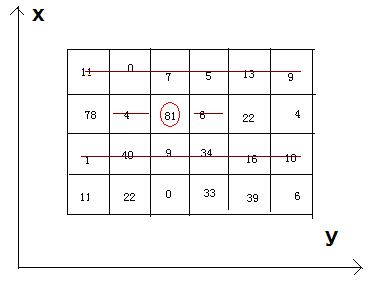Beans
Time Limit: 2000/1000 MS (Java/Others) Memory Limit: 32768/32768 K (Java/Others)
Total Submission(s): 3682 Accepted Submission(s): 1762
Problem Description
Bean-eating is an interesting game, everyone owns an M*N matrix, which is filled with different qualities beans. Meantime, there is only one bean in any 1*1 grid. Now you want to eat the beans and collect the qualities, but everyone must obey by the following rules: if you eat the bean at the coordinate(x, y), you can’t eat the beans anyway at the coordinates listed (if exiting): (x, y-1), (x, y+1), and the both rows whose abscissas are x-1 and x+1.

Now, how much qualities can you eat and then get ?

Now, how much qualities can you eat and then get ?
Input
There are a few cases. In each case, there are two integer M (row number) and N (column number). The next M lines each contain N integers, representing the qualities of the beans. We can make sure that the quality of bean isn't beyond 1000, and 1<=M*N<=200000.
Output
For each case, you just output the MAX qualities you can eat and then get.
Sample Input
4 6
11 0 7 5 13 9
78 4 81 6 22 4
1 40 9 34 16 10
11 22 0 33 39 6
Sample Output
242
Source
Recommend
一道很明显的dp题,隔行隔列相加之和最大,同样的dp列式使用两次。
题意:取其中一个数,则不能取相邻的两个数,最后取出数字之和为每行的最大子序列之和。
再在每行的子序列之和中取出几个数字,规则和取行数字相同,不能取相邻的数,最后之和为输出最终结果。
附上代码:
1 #include <iostream> 2 #include <cstdio> 3 #include <cstring> 4 #define N 200005 5 using namespace std; 6 int a[N],b[N],dp[N]; 7 int main() 8 { 9 int m,n,i,j; 10 while(~scanf("%d%d",&n,&m)) 11 { 12 dp[0]=a[0]=b[0]=0; //初始化 13 for(i=1; i<=n; i++) 14 { 15 for(j=1; j<=m; j++) 16 scanf("%d",&a[j]); 17 dp[1]=a[1]; 18 for(j=2; j<=m; j++) 19 dp[j]=max(dp[j-2]+a[j],dp[j-1]); //dp思想,取结果大的数据 20 b[i]=dp[m]; //b数组记录每一行的最大子序列和 21 } 22 dp[1]=b[1]; 23 for(i=2; i<=n; i++) 24 dp[i]=max(dp[i-2]+b[i],dp[i-1]); //完全一样的思想,只是前面去行的最大值,这里取列的最大值 25 printf("%d ",dp[n]); 26 } 27 return 0; 28 }